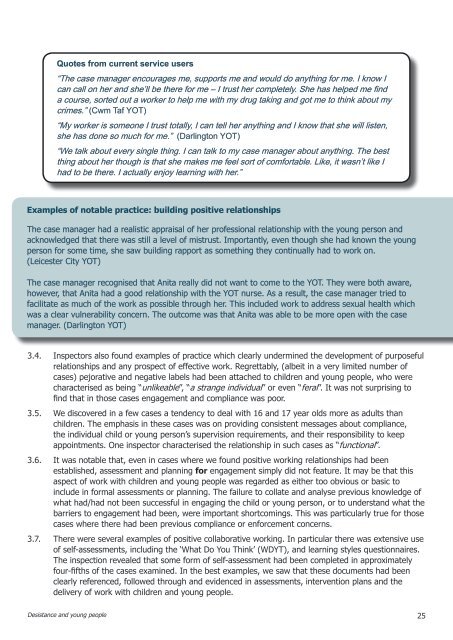Desistance and young people
Desistance_and_young_people
Desistance_and_young_people
You also want an ePaper? Increase the reach of your titles
YUMPU automatically turns print PDFs into web optimized ePapers that Google loves.
Quotes from current service users<br />
“The case manager encourages me, supports me <strong>and</strong> would do anything for me. I know I<br />
can call on her <strong>and</strong> she’ll be there for me – I trust her completely. She has helped me find<br />
a course, sorted out a worker to help me with my drug taking <strong>and</strong> got me to think about my<br />
crimes.” (Cwm Taf YOT)<br />
“My worker is someone I trust totally, I can tell her anything <strong>and</strong> I know that she will listen,<br />
she has done so much for me.” (Darlington YOT)<br />
“We talk about every single thing. I can talk to my case manager about anything. The best<br />
thing about her though is that she makes me feel sort of comfortable. Like, it wasn’t like I<br />
had to be there. I actually enjoy learning with her.”<br />
Examples of notable practice: building positive relationships<br />
The case manager had a realistic appraisal of her professional relationship with the <strong>young</strong> person <strong>and</strong><br />
acknowledged that there was still a level of mistrust. Importantly, even though she had known the <strong>young</strong><br />
person for some time, she saw building rapport as something they continually had to work on.<br />
(Leicester City YOT)<br />
The case manager recognised that Anita really did not want to come to the YOT. They were both aware,<br />
however, that Anita had a good relationship with the YOT nurse. As a result, the case manager tried to<br />
facilitate as much of the work as possible through her. This included work to address sexual health which<br />
was a clear vulnerability concern. The outcome was that Anita was able to be more open with the case<br />
manager. (Darlington YOT)<br />
3.4. Inspectors also found examples of practice which clearly undermined the development of purposeful<br />
relationships <strong>and</strong> any prospect of effective work. Regrettably, (albeit in a very limited number of<br />
cases) pejorative <strong>and</strong> negative labels had been attached to children <strong>and</strong> <strong>young</strong> <strong>people</strong>, who were<br />
characterised as being “unlikeable”, “a strange individual” or even “feral”. It was not surprising to<br />
find that in those cases engagement <strong>and</strong> compliance was poor.<br />
3.5. We discovered in a few cases a tendency to deal with 16 <strong>and</strong> 17 year olds more as adults than<br />
children. The emphasis in these cases was on providing consistent messages about compliance,<br />
the individual child or <strong>young</strong> person’s supervision requirements, <strong>and</strong> their responsibility to keep<br />
appointments. One inspector characterised the relationship in such cases as “functional”.<br />
3.6. It was notable that, even in cases where we found positive working relationships had been<br />
established, assessment <strong>and</strong> planning for engagement simply did not feature. It may be that this<br />
aspect of work with children <strong>and</strong> <strong>young</strong> <strong>people</strong> was regarded as either too obvious or basic to<br />
include in formal assessments or planning. The failure to collate <strong>and</strong> analyse previous knowledge of<br />
what had/had not been successful in engaging the child or <strong>young</strong> person, or to underst<strong>and</strong> what the<br />
barriers to engagement had been, were important shortcomings. This was particularly true for those<br />
cases where there had been previous compliance or enforcement concerns.<br />
3.7. There were several examples of positive collaborative working. In particular there was extensive use<br />
of self-assessments, including the ‘What Do You Think’ (WDYT), <strong>and</strong> learning styles questionnaires.<br />
The inspection revealed that some form of self-assessment had been completed in approximately<br />
four-fifths of the cases examined. In the best examples, we saw that these documents had been<br />
clearly referenced, followed through <strong>and</strong> evidenced in assessments, intervention plans <strong>and</strong> the<br />
delivery of work with children <strong>and</strong> <strong>young</strong> <strong>people</strong>.<br />
<strong>Desistance</strong> <strong>and</strong> <strong>young</strong> <strong>people</strong><br />
25


